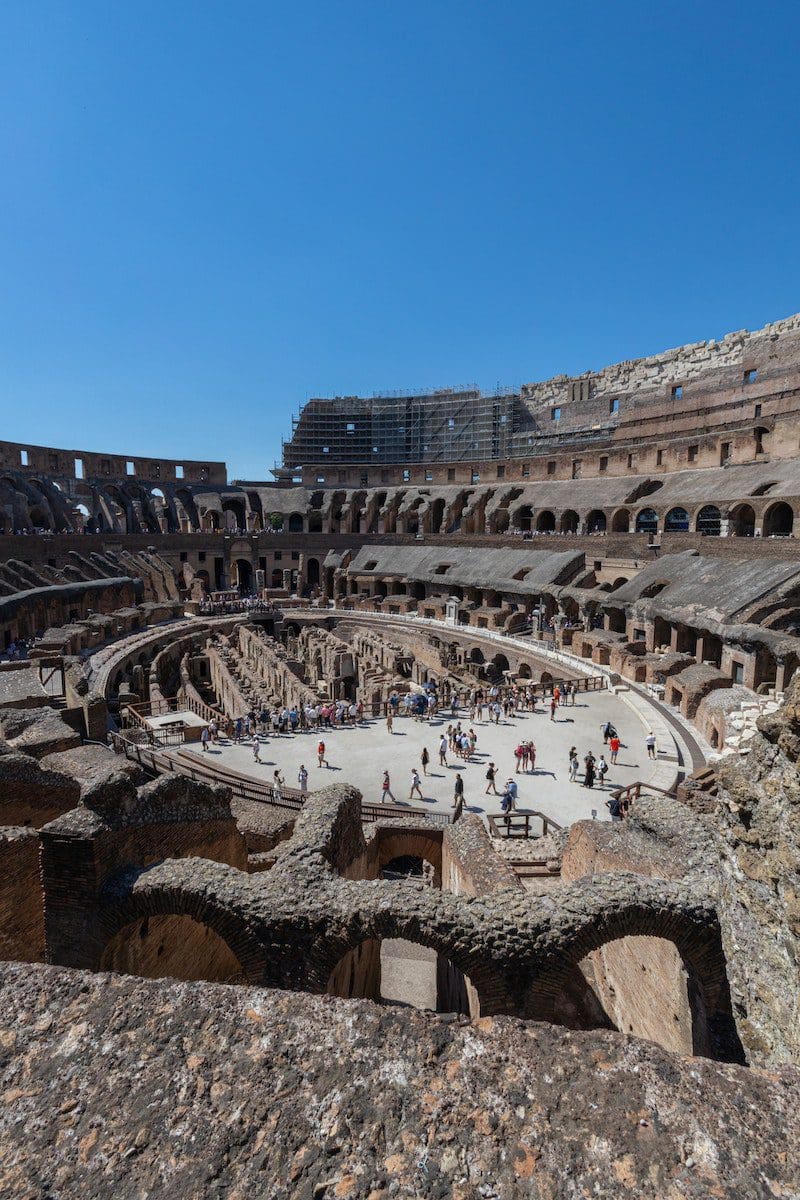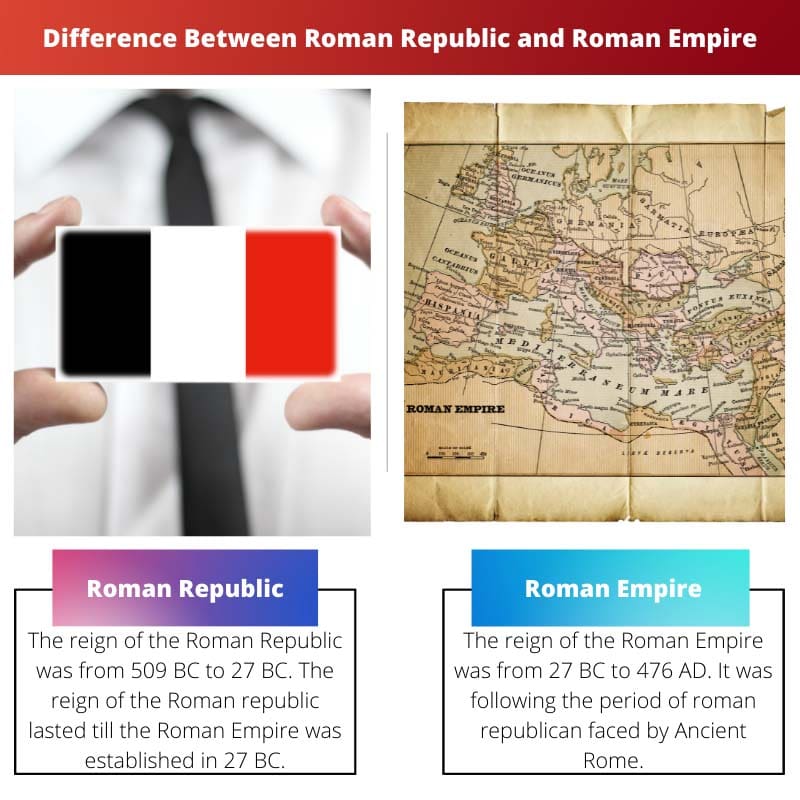Rome is a city with much ancient history and the civilizations associated with it. The history of the city is quite influential in today’s scenario. The city was founded by Romulus (one of the twin brothers).
In 509 BC, the Roman Republic era commenced, and in 27 BC, the Roman Empire was established. Both of them are two very important events in the history of Rome.
Key Takeaways
- The Roman Republic functioned as a representative democracy with a complex system of checks and balances. In contrast, the Roman Empire operated under an autocratic government led by an emperor.
- The Roman Republic valued the rule of law and the separation of powers, while the Roman Empire emphasized the centralization of authority in the hands of the emperor.
- The transition from the Roman Republic to the Roman Empire occurred due to internal conflicts, leading to the rise of Julius Caesar and Augustus Caesar, who established imperial rule.
Roman Republic vs Roman Empire
The difference between the Roman Republic and Roman Empire is that the ruling period of the roman republic was from 509 BC to 27 BC. During the republican period, the city followed the constitutional republic governance. Whereas comparatively on the other side, the ruling period of the roman empire was from 27 BC to 476 AD. And the roman empire followed the absolute monarchy system of governance during their reign.

Roman Republic was the period started after the Etruscans left Rome in 509 BC to 27 BC. The citizen adopted the Republic form of government to establish the work system.
The citizens of the Roman Republic used Latin as their official language and followed Roman polytheism as their religion. The Roman Republic government was resolved in 27 BC, and Roman Empire gets established.
Roman Empire was the period from 27 BC to 476 AD. The first emperor or the ruler of the reign was the adopted son of Julius Caesar, known as Augustus.
The successor of Augustus never took the title of the emperor or ruler; instead, they insisted on being called or known as the first citizen of Rome. The official language of the Roman Empire was the Greek and Latin languages.
Comparison Table
| Parameters of Comparison | Roman Republic | Roman Empire |
|---|---|---|
| Ruling Period | 509 BC – 27 BC | 27 BC – 476 AD |
| Official Language | Latin | Greek and Latin |
| Religion Practiced | Roman polytheism | Imperial cult polytheism |
| Type of Governance | Constitutional Republic | Absolute monarchy system |
| Preceded By | By the Roman Kingdom | By the Roman Republic |
| Succeeded By | Roman Empire | Western and Eastern Roman Empire |
What is Roman Republic?
The reign of the Roman Republic was from 509 BC to 27 BC. The reign of the Roman Republic lasted till the Roman Empire was established in 27 BC.
The Roman Republic government was established after Etruscan left Rome in 509 BC. Thus to form a system, people decided to accept the Republic system, which is still now used by the United States.
The Republic government includes the elected representatives from the society but still, the society plays a vital role. It is unlike that of the democratic form of government.
During the late Roman Republic times, the government classified three types of citizens – full citizens were allowed to vote, marry freeborn, and practice commerce, the second type of citizens wasn’t allowed to have a public office or cast a vote,
but still, they were allowed to practice other rights, the third type of citizens wasn’t allowed to practice any of the rights.
The official language used by the citizens was Latin. The people during the reign practised the roman polytheism religion.

What is Roman Empire?
The reign of the Roman Empire was from 27 BC to 476 AD. It was following the period of Roman republican faced by Ancient Rome.
The areas covered by Ancient Rome were North America, Europe, and West Asia. While the Roman Empire period was going on, the city experienced the most stability along with the highest territorial expanse in the first two centuries.
The Roman Empire was based on the absolute monarchy system, and thus the first emperor or the ruler of Ancient Rome was the adopted son of Julius Caesar, name Augustus.
Also, he never accepted the ruler’s title, and nor did his successor; they only claimed to be the first citizen of Rome.
The city accepted Greek and Latin as their official language. The religion followed by the people living in Ancient Rome during the reign of the Roman Empire was inspired by the Imperial cult of polytheism.
Although the city still followed the monarchy system, the emperor was threatened by the Palmyrene Empire, and the Gallic Empire broke the monarchy, which led to the empire being run by small empires.
Also, during the period in Ancient Rome established two courts: The western Roman Empire and Eastern Roman Empire, where later the western roman empire collapsed while the eastern roman empire survived.

Main Differences Between Roman Republic and Roman Empire
- The ruling period of the roman republic period was from 509 BC to 27 BC, whereas comparatively, on the other hand, the ruling period of the Roman Empire was from 27 BC to 476 AD.
- The official language used by the people living in the period of the Roman Republic was Latin, whereas comparatively, on the other hand, the official language used by the people during the period of the Roman Empire was the Greek language and the Latin language.
- The religion practised by the people during the Roman Republic period was Roman polytheism religion, whereas comparatively, on the other hand, the religion practised by the people during the Roman Empire was the imperial cult polytheism.
- During the reign of the roman republic, the constitutional republic was the governance type, whereas comparatively, on the other side, during the reign of the Roman empire, there was the absolute monarchy system.
- The predecessor of the roman republic was the Roman kingdom, whereas comparatively, on the other side, the predecessor of the Roman empire was the Roman republic.
- The successor of the roman republic was the Roman empire, whereas comparatively, on the other side, the successor of the Roman empire was the Western and Eastern Empire.

- https://repository.ubn.ru.nl/bitstream/handle/2066/113428/mmubn000001_052672816.pdf
- https://www.degruyter.com/document/doi/10.1515/9781400834907/html
- https://books.google.co.in/books?hl=en&lr=&id=BXf5bkC3r5YC&oi=fnd&pg=PR12&dq=difference+between+roman+republic+and+roman+empire&ots=JIUXwN0fZX&sig=pGUng56MTgdJ1lEJmc2NV8F70uE&redir_esc=y
- https://books.google.com/books?hl=en&lr=&id=XJ6_BwAAQBAJ&oi=fnd&pg=PP1&dq=difference+between+roman+republic+and+roman+empire&ots=l2nGZkKkVy&sig=tdaC44jwnblVXGbqyo3wB2IVRCY

This article provides detailed insight into the history of Rome and the significant differences between the Roman Republic and the Roman Empire. The transition from a republican form of government to an absolute monarchy system brought significant changes to Rome’s governance and society.
I agree, Tanya. The historical background of Rome is fascinating and the distinctions between the Republic and the Empire are crucial to understanding the city’s development and influence on modern governance.
The article provides a thorough overview of the historical periods of the Roman Republic and the Roman Empire, detailing the significant differences in governance, language, and religion. The comparison table effectively captures the contrasts between the two eras, contributing to a comprehensive understanding of Rome’s history.
Well stated, Tgray. The detailed analysis of governance systems and societal changes between the Republic and the Empire is instrumental in comprehending Rome’s historical and political evolution.
I agree, Tgray. The article’s comprehensive examination of the Roman Republic and the Roman Empire offers valuable insights into ancient governance and its impact on modern societies.
The article effectively highlights the transition from the Roman Republic to the Roman Empire, emphasizing the shift from a constitutional republic to an absolute monarchy system. This historical evolution is crucial to understanding the development of governance.
I concur, Richards. The article’s analysis of the governance systems and societal changes from the Republican era to the Empire provides valuable historical context and understanding of governance evolution.
Well articulated, Richards. The insights provided shed light on the transformation of governance structures, and the comparison table succinctly captures the key disparities between the Republic and the Empire.
The article’s comprehensive comparison between the Roman Republic and the Roman Empire offers profound insights into the historical and political evolution of Rome. Understanding the transition from a democratic republic to an absolute monarchy is essential to comprehending Rome’s rich history.
Well said, Cpalmer. The article effectively captures the critical differences in governance and societal structure between the Republican era and the Empire, offering valuable insights into the development of ancient governance systems.
The period of the Roman Republic and the Roman Empire symbolizes a significant shift in governance and societal structure. It’s interesting to note the influence of these periods on the development of human civilization.
Indeed, Jonathan. The impact of Rome’s history extends far beyond its borders, and understanding the differences between the Republic and the Empire sheds light on the evolution of governance systems.
The historical periods of the Roman Republic and the Roman Empire showcase the evolution of governance systems and the influence of centralization versus representative democracy. The contrast between the two eras is enlightening.
I couldn’t agree more, Jacob. The impact of these periods on modern political ideologies is noteworthy, and this article effectively conveys the significant differences between the Republic and the Empire.
The historical transition from the Roman Republic to the Roman Empire is intricately detailed in the article, shedding light on the evolution of governance and societal structure. The comparison of governance systems and language provides a comprehensive understanding of Rome’s historical progression.
Absolutely, Sienna. The article effectively delineates the historical periods of the Republic and the Empire, offering valuable insights into ancient governance systems and their influence on modern political ideologies.
The article provides a comprehensive overview of the transition from the Roman Republic to the Roman Empire, highlighting governance, language, and religion. It’s intriguing to compare the constitutional republic with the absolute monarchy.
Absolutely agree, Molly. The distinction between the two eras contributes to our understanding of ancient civilizations and their impact on modern societies.
I agree, Molly. The comparative analysis of the Republic and the Empire offers valuable insights into the historical and political evolution of Rome.
The detailed comparison between the Roman Republic and Roman Empire offers profound insights into the historical and political evolution of Rome. Understanding the transition from a constitutional republic to an absolute monarchy is essential to comprehending Rome’s rich history.
Absolutely, Ward. The delineation of governance systems and societal structure between the Republic and the Empire provides a comprehensive understanding of Rome’s historical progression and influence on modern governance.
The delineation of the Roman Republic and Roman Empire provides a clear understanding of the city’s historical progression and the shift in governance. The comparison table succinctly captures the differences between the two eras.